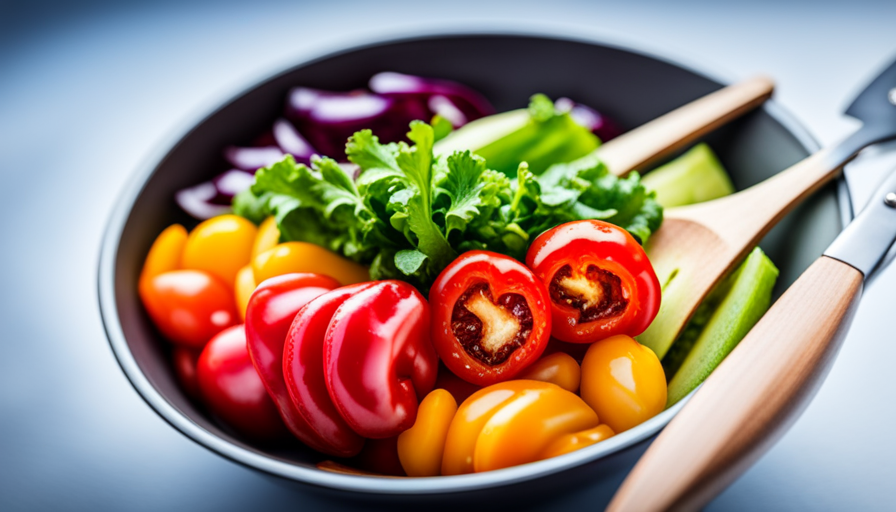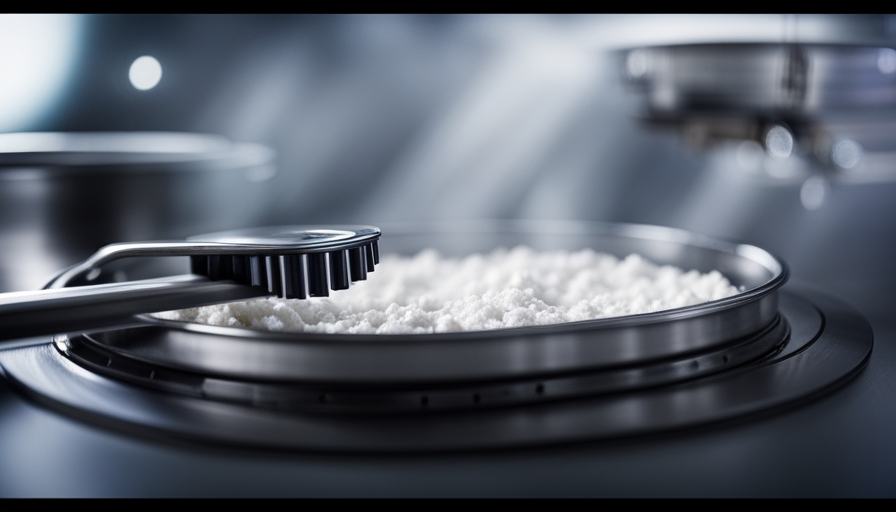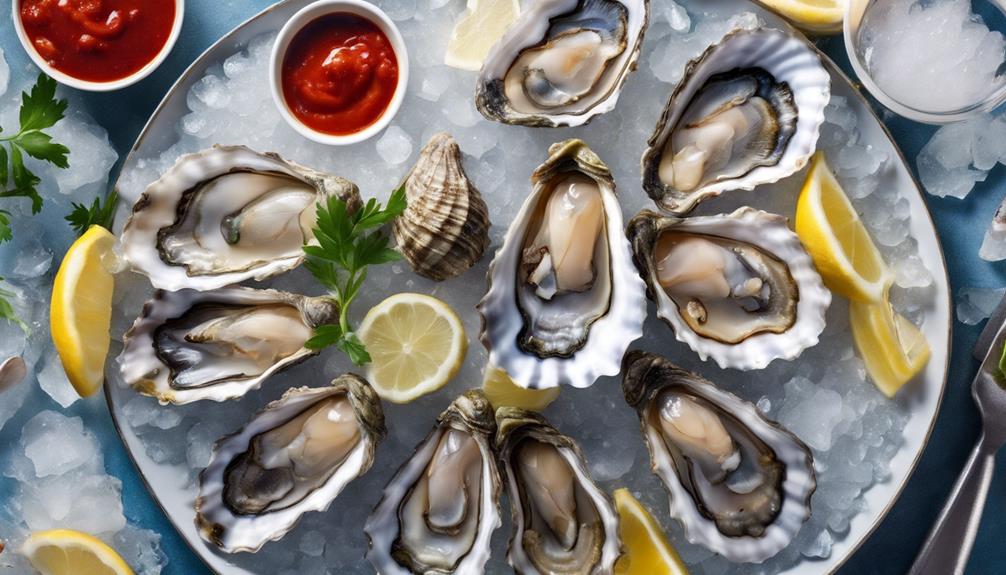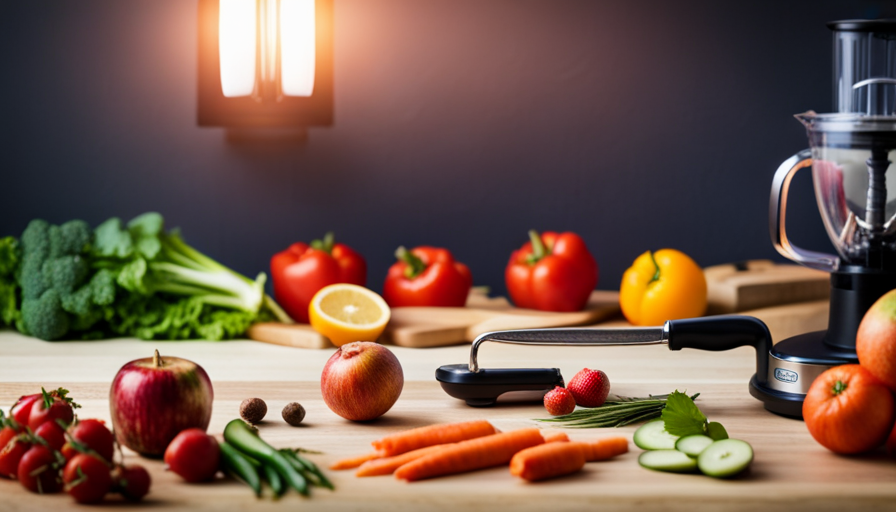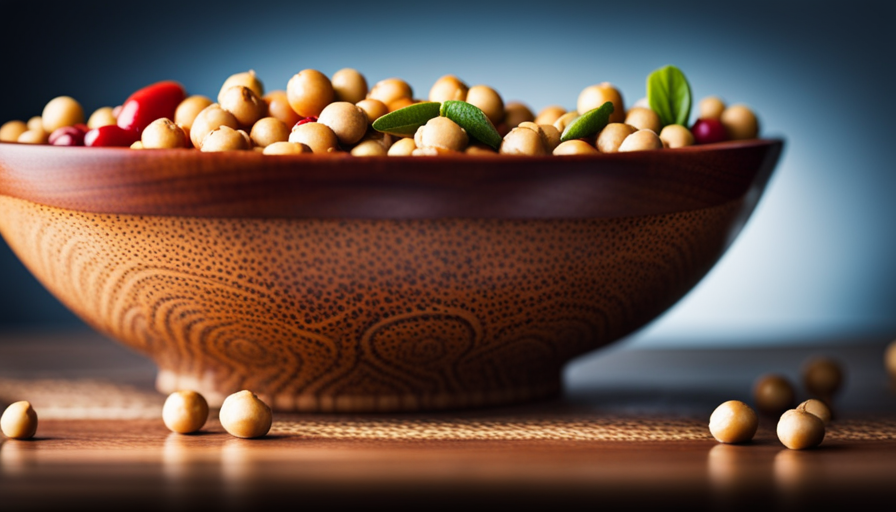Have you ever thought about experiencing a diet that consists of only raw and unprocessed foods?
Well, let me take you on a culinary journey through the world of the raw food diet. Picture yourself waking up in the morning, feeling energized and ready to take on the day. Instead of reaching for that cup of coffee, you indulge in a fresh fruit bowl that not only satisfies your taste buds but also nourishes your body with essential vitamins and minerals.
As the day goes on, you savor a colorful and nutrient-rich salad for lunch, followed by a refreshing green smoothie as a mid-day snack. For dinner, you enjoy a hearty and flavorful zucchini pasta that leaves you feeling satisfied and content. And to top it all off, you delight in a decadent raw chocolate avocado mousse for dessert.
Throughout the day, you stay hydrated with infused water that not only quenches your thirst but also adds a burst of flavor.
This is just a glimpse into the world of the raw food diet, a lifestyle that focuses on consuming foods in their natural state to maximize their nutritional benefits.
So, if you’re ready to embark on a journey of health and wellness, let’s dive in and discover the typical meals eaten when on the raw food diet.
Key Takeaways
- The raw food diet consists of consuming foods in their natural state for maximum nutritional benefits.
- A typical day on the raw food diet includes a fresh fruit bowl for breakfast, a nutrient-rich salad for lunch, a green smoothie for a snack, and zucchini pasta for dinner.
- The raw food diet focuses on incorporating leafy greens, chopped vegetables, and avocado dressing for nutrients, fiber, and crunch.
- Raw food desserts like raw chocolate avocado mousse can be enjoyed as a delicious and nutritious option, made with ripe avocados, cacao powder, and alternative sweeteners like raw honey or dates.
Breakfast: Energize Your Morning with a Fresh Fruit Bowl
Start your day off right with a delicious and energizing fresh fruit bowl! When following a raw food diet, it’s important to fuel your body with nutritious and energizing breakfast ideas. A fresh fruit bowl is the perfect choice, as it’s packed with vitamins, minerals, and antioxidants that provide a natural boost of energy to start your day.
One of the benefits of a raw food diet is that it allows you to consume foods in their most natural state, preserving their nutritional content. Fresh fruits are an excellent source of essential nutrients such as vitamin C, potassium, and fiber. These nutrients not only provide energy but also support a healthy immune system, aid in digestion, and promote overall well-being.
To create an energizing fresh fruit bowl, choose a variety of colorful fruits such as berries, melons, and citrus fruits. These fruits are rich in antioxidants, which help fight against free radicals and reduce the risk of chronic diseases. Additionally, the natural sugars found in fruits provide a quick source of energy without the crash associated with processed sugars.
Incorporating a fresh fruit bowl into your morning routine is a simple and delicious way to kickstart your day on a raw food diet. It provides essential nutrients, boosts energy levels, and supports overall health. Transitioning into lunch, savor a colorful and nutrient-rich salad that’ll keep you satisfied throughout the day.
Lunch: Savor a Colorful and Nutrient-Rich Salad
For lunch on the raw food diet, I like to savor a colorful and nutrient-rich salad. I start by creating a bed of leafy greens, such as spinach or kale, which provide a great source of vitamins and minerals.
Next, I add a rainbow of chopped vegetables, such as bell peppers, carrots, and tomatoes, to add crunch and variety to the salad.
Finally, I top it off with a creamy avocado dressing, which not only adds a delicious flavor but also provides healthy fats that are essential for the body.
Start with a Bed of Leafy Greens
To create a raw food meal, start with a bed of leafy greens. Lay down a lush green carpet inviting you to dive into a world of vibrant health. Leafy greens are a cornerstone of the raw food diet. They provide essential nutrients, fiber, and a refreshing crunch. Kale, spinach, romaine lettuce, and arugula are excellent options. These greens are low in calories but high in vitamins, minerals, and antioxidants that support overall well-being. They also offer a good amount of chlorophyll, which aids in detoxification and supports healthy digestion. By starting your meal with leafy greens, you set the foundation for a nutritious and satisfying raw food experience.
Now, let’s move on to the next section and add a rainbow of chopped vegetables to enhance both the flavor and nutritional profile of your salad.
Add a Rainbow of Chopped Vegetables
A vibrant burst of colors can be achieved by incorporating a variety of chopped vegetables into your leafy green base. This not only adds visual appeal to your meal, but also provides a wide array of nutrients and health benefits.
-
Rainbow veggie benefits: Including different colored vegetables in your meal ensures that you’re getting a diverse range of vitamins, minerals, and antioxidants. Red peppers, for example, are rich in vitamin C and beta-carotene, while purple cabbage is packed with anthocyanins that have anti-inflammatory properties.
-
Creative veggie combinations: Mixing and matching various vegetables can create interesting flavor profiles and textures. Try adding sliced cucumbers for a refreshing crunch, cherry tomatoes for a burst of sweetness, and grated carrots for added color and texture.
By incorporating a variety of chopped vegetables into your meal, you can create a visually appealing and nutrient-rich dish. Next, we’ll top it off with a creamy avocado dressing.
Top with a Creamy Avocado Dressing
With a dollop of velvety avocado dressing, your vibrant vegetable creation will be transformed into a creamy oasis of flavor and texture. Not only does this dressing add a delicious creaminess to your meal, but it also provides a wealth of benefits when incorporated into a raw food diet.
Avocados are packed with healthy fats, fiber, and a variety of nutrients that can support overall health. They’re rich in vitamins, minerals, and antioxidants, which can help boost the immune system and reduce inflammation. Additionally, avocados are known to promote heart health and support healthy digestion.
If you’re looking for alternatives to creamy avocado dressing, you can try using other creamy ingredients like tahini or cashew butter. These alternatives can provide a similar texture and flavor, while still offering beneficial nutrients.
Now, let’s move on to the next section about indulging in a refreshing green smoothie.
Snack: Indulge in a Refreshing Green Smoothie
Indulge in a refreshing green smoothie, packed with wholesome greens and bursting with vibrant flavors. Green smoothies have become increasingly popular due to their numerous health benefits and delicious taste. They’re a great way to incorporate more vegetables into your diet and provide a boost of nutrients. Here are five reasons why you should consider adding green smoothies to your daily routine:
- Green smoothies are an excellent source of vitamins and minerals, including vitamin C, vitamin K, and potassium.
- They’re rich in antioxidants, which can help protect your body against free radicals and reduce the risk of chronic diseases.
- Green smoothies are a convenient way to increase your intake of fiber, which aids in digestion and promotes a feeling of fullness.
- They can help support weight loss goals by providing a nutrient-dense and low-calorie option for a meal or snack.
- Green smoothies are incredibly versatile, and there are countless recipes available to suit your taste preferences and dietary needs.
Now, let’s move on to dinner: enjoy a hearty and flavorful zucchini pasta.
Dinner: Enjoy a Hearty and Flavorful Zucchini Pasta
Savor the depths of flavor in a bowl of zucchini pasta that will transport your taste buds to a garden oasis. Zucchini pasta is a popular choice for raw food enthusiasts looking for a delicious and satisfying dinner option. It is not only tasty but also incredibly nutritious. By using zucchini as a base, you can create a pasta-like dish without the need for traditional wheat or grain-based noodles.
For those looking for zucchini pasta alternatives, there are plenty of options to explore. You can try using other spiralized vegetables like carrots or cucumbers to create a colorful and flavorful dish. Additionally, you can experiment with different sauces and toppings to add variety to your zucchini pasta recipes. From creamy avocado pesto to tangy tomato marinara, the possibilities are endless.
To provide a deeper understanding, here is a table showcasing the nutritional content of zucchini pasta compared to traditional wheat-based pasta:
| Nutrient | Zucchini Pasta | Wheat Pasta |
|---|---|---|
| Calories | 33 | 221 |
| Carbohydrates | 6g | 43g |
| Fiber | 2g | 3g |
| Vitamin C | 35% | 0% |
| Vitamin A | 10% | 0% |
As you can see, zucchini pasta is lower in calories and carbohydrates while being higher in fiber and essential vitamins. It is a fantastic option for those following a raw food diet.
Now, let’s move on to the next section where we will dive into the delightful world of raw food desserts.
Dessert: Delight in a Decadent Raw Chocolate Avocado Mousse
When it comes to raw desserts, one of my absolute favorites is the decadent raw chocolate avocado mousse. To make this luscious treat, simply blend ripe avocados, cacao powder, and a touch of maple syrup for sweetness. Don’t forget to add a pinch of sea salt to balance out the flavors.
And if you’re feeling fancy, top it off with some fresh berries or shredded coconut for an extra burst of flavor and texture.
Blend Avocado, Cacao Powder, and Maple Syrup
Mix together avocado, cacao powder, and maple syrup to create a deliciously creamy and naturally sweet treat. Avocado provides a smooth and velvety texture, while cacao powder adds a rich and indulgent chocolate flavor. Maple syrup, a natural sweetener, enhances the sweetness without the need for refined sugar.
Incorporating cacao powder into a raw food diet offers numerous benefits. Firstly, it is packed with antioxidants, which help protect the body against free radicals and reduce the risk of chronic diseases. Additionally, cacao powder contains minerals like magnesium and iron, which are essential for maintaining proper bodily functions.
For those looking for alternatives to maple syrup, there are several options available. One alternative is using raw honey, which provides natural sweetness and also offers antibacterial properties. Another option is using dates or date paste, which adds a rich sweetness and a chewy texture to the dessert.
To add a pinch of sea salt for balance, simply sprinkle a small amount over the mousse. The salt enhances the flavors of the avocado, cacao powder, and maple syrup, creating a harmonious blend of sweet and savory.
Add a Pinch of Sea Salt for Balance
Enhance the harmony of flavors in this creamy dessert by sprinkling just a pinch of sea salt over the indulgent blend of avocado, cacao powder, and maple syrup. Sea salt not only adds a subtle savory note to the sweetness of the dessert but also offers several health benefits. Sea salt contains essential minerals like magnesium, potassium, and calcium, which are important for maintaining proper bodily functions. Additionally, it can help balance electrolytes, support digestion, and improve hydration.
If you prefer to avoid using sea salt, there are alternatives such as Himalayan pink salt or Celtic sea salt that can provide similar benefits. Adding a pinch of sea salt truly elevates the taste of this dessert, creating a perfect balance of flavors. Now, for an extra touch of freshness, you can top it with fresh berries or shredded coconut.
Optional: Top with Fresh Berries or Shredded Coconut
To add an extra touch of freshness to this creamy dessert, try topping it with a handful of juicy berries or a sprinkle of shredded coconut. Fresh berries not only add a burst of color to your dish, but they also provide a delightful sweetness that complements the creaminess of the raw food dessert. Whether you choose strawberries, blueberries, or raspberries, these nutrient-packed fruits are a great source of antioxidants, vitamins, and fiber. Shredded coconut, on the other hand, adds a subtle tropical flavor and a satisfying crunch to each bite. It’s rich in healthy fats and contains essential minerals like manganese and copper. So go ahead and get creative with your toppings to enhance the flavors and textures of your raw food dessert. Now, let’s move on to the next section about staying refreshed with infused water.
Hydration: Stay Refreshed with Infused Water
Quench your thirst and stay cool during the raw food diet by enjoying the refreshing taste of infused water. Infused water not only helps you stay hydrated but also adds a burst of flavor to your meals.
There are numerous benefits to incorporating infused water into your diet. Firstly, it helps curb your cravings for sugary beverages by providing a healthier alternative. Additionally, infused water is packed with essential vitamins and minerals, making it a great way to boost your nutrient intake.
To make infused water, simply add your favorite fruits, herbs, or vegetables to a pitcher of water and let it sit for a few hours. The possibilities for creative infused water recipes are endless. You can experiment with combinations like cucumber and mint, lemon and ginger, or strawberry and basil. These flavors not only add a refreshing twist to your water but also provide additional health benefits. For example, cucumber is known for its hydrating properties, while ginger aids digestion and boosts the immune system.
Incorporating infused water into your raw food diet is a simple yet effective way to stay hydrated and enhance your overall wellness. So, why not get creative and start enjoying the benefits of infused water today?
Frequently Asked Questions
Can I drink coffee or tea while on the raw food diet?
Drinking coffee or tea on the raw food diet can hinder health benefits. Avoiding these beverages allows the body to thrive on the natural nutrients found in raw foods. Coffee and tea contain caffeine, which can disrupt sleep patterns and dehydrate the body. Moreover, they may interfere with the absorption of essential minerals. By abstaining from coffee and tea, one can fully embrace the nourishing qualities of the raw food diet and optimize their well-being.
How do I ensure I’m getting enough protein on the raw food diet?
To ensure I’m getting enough protein on the raw food diet, I focus on incorporating protein-rich foods into my meals. Some excellent raw food diet protein sources include nuts, seeds, legumes, and leafy greens.
I also make sure to include a variety of these protein sources in my diet to ensure I’m getting a complete amino acid profile. Additionally, incorporating fermented foods like tempeh and miso can provide a good amount of protein.
Are there any specific foods I should avoid on the raw food diet?
When it comes to the raw food diet, there are a few foods to avoid due to potential health risks. One example is raw sprouts, which can harbor harmful bacteria like E. coli or Salmonella. These bacteria can cause serious foodborne illnesses.
Another food to be cautious of is raw eggs, as they may contain Salmonella. It’s important to prioritize food safety and opt for cooked sprouts and eggs to minimize the risk of getting sick.
Can I still eat cooked food occasionally while following the raw food diet?
Yes, it’s possible to occasionally eat cooked food while following the raw food diet. However, it’s important to note that the raw food diet emphasizes consuming unprocessed, plant-based foods. While cooked food alternatives can be incorporated, the benefits of occasional cooked food may include increased digestibility and the release of certain nutrients. It’s crucial to maintain a balance and prioritize raw food consumption to fully reap the benefits of this diet.
How long does it typically take to see results on the raw food diet?
Results on the raw food diet? Well, it’s like waiting for a snail to win a marathon. But hey, patience is a virtue, right?
Generally, it takes some time to see noticeable changes. Most people start experiencing benefits within a few weeks, like increased energy, improved digestion, and weight loss. But remember, everyone’s body is different, so results may vary.
Just stick to those fresh fruits and veggies, and let nature do its thing.
What Are Some Common Meals Eaten on the Raw Food Diet?
Some common meals eaten on the raw food diet include salads, smoothies, and raw nut-based dishes. The key is to eat foods that have not been heated above 118 degrees Fahrenheit, as this is the ideal temperature for raw food to retain its nutrients and enzymes.
Conclusion
In conclusion, the raw food diet is a game-changer for your health. It’s a culinary journey that will leave you feeling rejuvenated and alive! With its energizing fruit bowls, nutrient-rich salads, refreshing green smoothies, hearty zucchini pasta, and decadent raw chocolate avocado mousse, this diet takes your taste buds on a wild adventure. And let’s not forget about the infused water that keeps you hydrated throughout the day. Trust me, this diet isn’t for the faint-hearted.
So why wait? Dive into the world of raw food and experience the extraordinary benefits for yourself.

